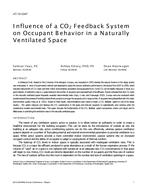
AT-15-C067 — Influence of a CO2 Feedback System on Occupant Behavior in a Naturally Ventilated Space
- Comments Off on AT-15-C067 — Influence of a CO2 Feedback System on Occupant Behavior in a Naturally Ventilated Space
- ASHRAE
Architecture Hall, located on the University of Washington Campus, was renovated in 2005 whereby the natural function in the design studios was re-activated. A series of experimental methods were developed to assess the natural ventilation performance in the studios from 2007 to 2009, which included measurement of CO2 levels and other indoor environmental parameters during occupied hours. Since CO2 can be readily measured, it serves as a good indicator of ventilation rates in a space relative to the number of occupants and associated level of bio-effluents. Results indicated that the CO2 levels in the naturally ventilated spaces frequently exceeded recommended levels (Ilyas, Emery and Heerwagen 2010). Surveys were also conducted which pointed towards the presence of building related illness symptoms amongst the occupants and a large number of occupants being dissatisfied with the indoor environmental quality (Ilyas et al. 2012). Based on these results, recommendations were made to install a CO2 feedback system in one of the design studios – this system measures and displays the CO2 concentration in the space and instructs occupants to systematically open windows when theconcentration exceeds recommended levels. This paper discusses the fundamentals of the CO2 feedback system (components, criteria and setup) and its effectiveness in controlling the ventilation rates in the naturally ventilated space.
Product Details
- Published:
- 2015
- Number of Pages:
- 8
- Units of Measure:
- Dual
- File Size:
- 1 file , 840 KB
- Product Code(s):
- D-AT-15-C067
- Note:
- This product is unavailable in Russia, Belarus

